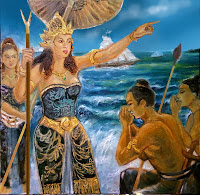SAJIWAN TEMPLE
Sajiwan or Sojiwan Temple is a Buddhist temple, located in Dukuh Kalongan, Kebondalem Kidul Subdistrict, Prambanan District, Klaten Regency. The temple contains about 20 relief on his foot, relating to The Story Jataka Pancatantra from India. From 20 reliefs, there are 19 reliefs now. The temple is located about 2 km south of Prambanan Temple. From the Tourism Gate of Prambanan Temple, acrossing Solo - Yogyakarta Highway, then get to small street to the south, acrossing the railway line, and then at the first intersection, turn left (to the east). About 200 m from the intersection, there is a small temple, could be seen at the south side of the street. The reconstruction of Sajiwan Temple was begun in 2006, led by Mr. Waliman from Balai Pelestarian Peninggalan Purbakala (BP3) of Central Java and Special Teritory of Yogyakarta
Restoration process of the temple is about 65% finished. The temple height is about 27,5 metres, but the restoration still reach about 10 metres height. The restoration was finished in 2011.
Sajiwan Temple is located at the ranks of Sewu Mountains, at Batur Agung Hill, among other several archeological sites there, such as Miri Temple, Gatak Site, and Ganesha Statue, those located at the south side of the hill.
Sajiwan Temple is an ancient monument of The Ancient Medang Kingdom of 9th Century, at the era of Rakai Panangkaran Pu Manuku and his consort, Sri Kahulunan or Pramodhawardhani.
The temple was first discovered by Kolonel Colin MacKenzie in 1813.
He was a official staff of Raffles and he had a research on the remaining stones of the temple wall. The research was countinued by Baker and his research was reported in History of Java in 1830. But, in his research, he did not find the remaining temple wall. He thought that the rest of the wall had been removed or moved somewhere by surrounding peole at that time.
In 1893 Jogjasche Archaelogische Vereeniging (Assembly of the Yogyakarta Archaeological Bureau), led by H.E. Dorrepaal, began to clean up surrounding environment of the temple. In 1913 most of the remaining stones of the temple had been saved to The Temple Complex Area of Prambanan.
This temple is situated at the slope of hill near Boko Temple Complex, at the height of 146 to 150 above sea level or about 1 km from the south-east of Prambanan Temple. It was built around 842 - 850 AD at the same period of Plaosan Temple. Rukam Inscription from 829 Saka or 907 AD explains about Inauguration Ceremony for the restoration of Rukam Village, after the village was destroyed by Vulcanic Eruption of Mount Merapi.
Residents of Rukam Village were given a duty to preserve and to keep saved the sacred/holy temple at Limwung Village. The holy temple was Sajiwan Temple. The temple was built as a Pedharman Temple by Pramodhawardhani. Sajiwan Temple has an unique style of 9th Century Central Java, consisted of three parts : base or feet, body, and roof. It is located at the centre of 8.140 square metres area, with the main building about 40,1 m2 and 27 m height. It faces to the west.
There is a damaged statue of Dwarapala, now preserved at the Security Checkpoint of the temple area. The foot of the temple contains the Story of Jataka. The east side of the temple staircase is covered by Makara, but unfortunately one of the Makara had been lost several years ago. a Kala style is carved at the end of the staircase, at the top of temple gate. The temple body is full carved in Sulur ornament. But, unfortunately, the temple rooms are empty now, because some statues of Boddhisatva are not there. They had been stolen or moved to National Museum in Jakarta. There is a statue of Buddha without head only, near Security Checkpoint of the temple.
Some reliefs of Sajiwan Temples are the reliefs of :
Two fighting men.
a swan and a turtoise.
a monkey and a crocodile.
a rat and a snake.
a wolf and a woman.
a king and his consort, with a Patih.
an elephant and a goat.
a Lion-Man creature.
a Kinara.
a Buffalo and a Lion.
Balai Pelestarian Peninggalan Purbakala (BP3) of Central Java and Special Teritory of Yogyakarta is still planning to finish the temple restoration three years after 2011.
Mr. Waliman, as the chief of Team told that the restoration process still reach about 65 % finished now. He hopes that the next restoration could be held in the next years soon.








Komentar
Posting Komentar